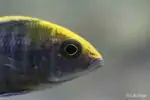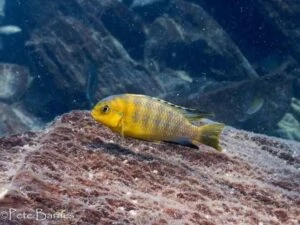Aulonocara maylandi – Sulfurhead Aulonocara
In 1984, Aulonocara maylandi was first described by Trewavas. The name maylandi is a reference to the German aquarist Hans Mayland. Aulonocara comes from Greek; aulos=flute and caras is face and refers to the pores on the head that resemble the holes of a flute. Their common name is Sulfurhead Aulonocara, a reference to the sulfur-coloured blaze on their head and back.
Description
There are two varieties of this species. In the South East of Lake Malawi near West Reef and Eccles Reef, the variant with the yellow stripe occurs, the so-called Sulpherhead Aulonocara. The male has a beautiful yellow stripe across his head that runs from his nose to the back of his dorsal fin.
De tweede variant komt alleen voor bij Kande Island. Deze varaint heeft een wittige streep op zijn kop en rugvin, de rest van de kleuren is gelijk aan de Sulpher Head. Daarnaast heeft deze variant een wat vergroot onderste faryngeaal botje (onderste deel van de keelkaak). Deze variant is in 1987 door Tawil en Allgayer Aulonocara maylandi kandeensis genoemd. Twee jaar later hebben Eccles en Trewavas hem weer teruggezet als Aulonocara maylandi. Update: in 2016 heeft Konings de variant van Kande Island weer verheven tot aparte soort: Aulonocara kandeense.
In contrast to most Aulonocara females, the Aulonocara maylandi female is more silver than brown/grey.
Like most Aulonocaras, the species is peaceful towards others. Preferably do not keep in a crowded aquarium. Suitable tankmates are, for example, smaller Copadochromis or Placidochromis species. Do not keep them with multiple Aulonocara species because they can interbreed.
Biotope
This species lives mainly in the transition zone from rocks to sand and can be found between Eccles Reef and Makanjiila Point (yellow variety). Near Kande Island, the white stripe variety can be found.
They live there at a depth of around 10 meters. The adult males occupy a territory where they try to lure females. The females form foraging groups.
Diet
By filtering sand, it captures invertebrates that live in the sand. In the aquarium, you can feed Aulonocara maylandi with frozen or live food such as mysis, brine shrimp, finely chopped shrimp, etc. A Malawi mix is also a good option. Often this contains not only meat-like ingredients but also some green food such as spirulina.
The Aquarium
To simulate the habitat for the Aulonocara maylandi, you can set up the aquarium with a few piles of rocks, in between you place fine sand as a substrate. Because they often dive in the sand in search of food, we do not recommend using gravel. Too coarse or sharp gravel can damage their snout and gills or clog their gut if they ingest it.
The aquarium should be at least 120 centimetres wide for this species.
Breeding aquarium and conditioning
Normally you can just breed Aulonocara maylandi in a multi-species aquarium. Make sure that the male has several females at his disposal. The males are always willing to mate and can constantly chase the females. To reduce this pressure it is necessary to give the male 3 to 4 females.
If you want to keep a maximum number of fry, it is advisable to put them in a separate aquarium so that they are not disturbed by other fish when spawning.
The Spawn
Once a female has indicated that she wants to lay eggs, the male chooses a patch of open sand. He lures the female by flaring his fins and showing his flank as he swims over the bottom. They will circle each other for a while. When ready, the female lays a few eggs in the sand. She turns around and takes the eggs in her mouth. The male circles her and slides his anal fin over the bottom. There are egg spots on this anal fin. The female tries to pick up the eggs on his anal fin but in doing so ingests the male’s hom with which the eggs are fertilized.
Raising the fry
The female incubates the eggs in her mouth. She keeps the eggs for up to 28 days. The female does not eat (much) while incubating, so you will see her lose some weight.
After about 28 days, the female spits out the fry. They are free-swimming fish that can be fed directly with finely crushed flake food or, for example, brine shrimp.
When the female spits out the fry into an aquarium, most of the fry serve as food for the other fish. If you want to keep more fry, you can catch the female around day 20 and keep her in a separate aquarium. The female will spit out the fry but not eat them for the first few hours. Remove the female and place her back with the other fish. Keep the time she is apart as short as possible to avoid losing her place in the pecking order.
Conclusion
The bright yellow stripe makes the Sulpher Head an attractive Aulonocara species. It is important to fine-tune the tankmates because Aulonocara maylandi is not one of the strongest species.
Video
Author
John de Lange
Copyright images
John de Lange
Resources
Fishbase.org
Seriouslyfish.com
Malawi Cichliden in hun Natuurlijke omgeving (Ad Konings).

























Reviews
There are no reviews yet.